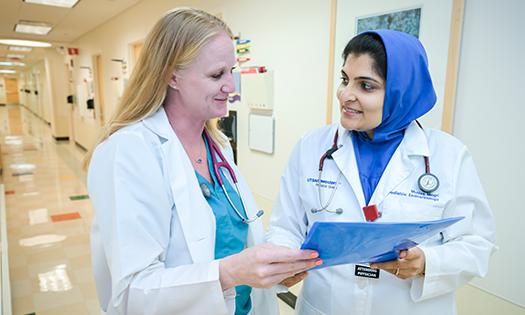Better outcomes, faster recovery, smaller scars, less pain and fewer pain medications are among the benefits of minimally invasive surgery (MIS).
At Children's Health ℠, we’ve built a comprehensive, top-notch MIS program by focusing on extensive training, an innovative culture and making deep investments in leading-edge technology.
“Our commitment to these three pillars of our program – training, culture and technology – makes it possible for everyone on our team to routinely perform complex minimally invasive pediatric procedures with the best outcomes,” says Samir Pandya, M.D., Pediatric Surgeon at Children’s Health and Associate Professor at UT Southwestern. “Today, we treat more pediatric patients with minimally invasive procedures than any center in North Texas.”
Simulation Training: The Path to Excellent, Consistent MIS Outcomes
Children’s Health and UT Southwestern have one of the few approved fellowship training programs in pediatric surgery in North America. Our team has been training the future of pediatric surgeons since 1995.
Our rigorous two-year training program ensures that all surgeons on our team can perform the most advanced MIS techniques on children of all sizes.
Though the program is geared toward fellows, every surgeon on the team can attend the 10-12 annual sessions to practice the latest techniques, visualize procedures, ask questions and collaborate.
"High fidelity simulations are the best way to practice the nuanced movements needed to successfully perform MIS on even the smallest newborns,” Dr. Pandya explains.
During the sessions, the surgeons practice key surgical skills on fetal bovine tissue, which simulates the feel of human tissue. The curriculum focuses on four core surgical principles that prepare them for any surgical procedure:
Dissecting: Surgeons use the bovine models to perform a pneumonectomy (lung removal), which enables them to practice exposing and identifying structures within the smallest spaces.
Suturing minimally invasively: Practicing hernia repair surgery enables the team to refine the overall skill set of sewing within incisions that measure four millimeters or smaller.
Sewing small structures in the chest: Surgeons perform esophageal atresia repair surgery to practice connecting small structures, such as the esophagus, in the chest. The goal is to place eight stitches in a 1-cm diameter tube and demonstrate that it’s watertight.
Sewing small structures in the abdomen: By practicing intestinal atresia repair surgery, surgeons prepare for complex procedures in the abdomen.
“Because we train together, each child that comes to our center receives the same outstanding MIS care no matter which surgeon performs their procedure,” Dr. Pandya says.
A Culture Committed to the Smallest Possible Incision
The first priority of minimally invasive surgery is to provide safe, high-quality care that produces the best outcomes. The next is to ensure the smallest possible scar, or no scar at all.
“In addition to cosmetic benefits, smaller incisions mean less scar tissue and likely fewer pain medications, too,” Dr. Pandya says. “We’ve cultivated a very collaborative culture so we’re constantly thinking outside the box together to make each procedure as minimally invasive as possible.”
In one recent case, the team came together to plan treatment for a 1.7 kilogram newborn with severe Type B esophageal atresia. The treatment plan included minimally invasive techniques for everything from the diagnostics to the gastrostomy to the repair surgery itself.
“To perform these complex procedures within such a tiny space, we used several innovative techniques. For the repair surgery, we used metal clips to gently stretch the ends of the baby's esophagus and a slip knot technique to connect the esophagus," Dr. Pandya says. “It really comes down to our collective commitment to using the smallest incisions possible, which enables us to treat the most complex patients, like this tiny baby, entirely with MIS.”
Driving Surgical Innovation with the Latest Technology
Investing in the latest technology enables our team to remain at the forefront of our field and provide the best outcomes.
"Advanced tools like virtual reality and 3D printing take planning a complex minimally invasive surgery to a whole different level," Dr. Pandya says. “We’ve started using this technology for procedures that remove tumors or treat complex congenital conditions. It helps us visualize the surgery in advance with an eye toward the best possible results.”
For example, this technology is often used to plan MIS procedures for children with chest wall deformities. By 3D printing the child’s anatomy, the surgeon is able to plan the least invasive surgical approach and determine how the chest wall will appear after the procedure. This information also helps the team and the patient prepare in advance for any follow-up care.
“We’ve only scratched the surface of the capabilities of this technology, but we’re exploring new applications and incorporating it into more surgical approaches to continue to drive MIS innovation,” Dr. Pandya says.
Why Children’s Health: A Level 1 Children’s Surgery Center
Children’s Health is home to some of the nation’s top pediatric surgeons. Children’s Medical Center Dallas is designated as a Level I Children’s Surgery Center by the American College of Surgeons, which recognizes our ability to deliver the highest level of quality surgical care for all pediatric patients – from the most complex cases to common conditions. Our team is committed to the training, culture and technology that continuously raises the bar on pediatric minimally invasive surgery.
“Providers often refer to our team when there’s a particularly complex case that could be treated minimally invasively,” Dr. Pandya says. “We collaborate with referring providers to learn about the patients and work together to provide the highest quality care.”
Learn more about innovative surgical care at Children’s Health and refer a patient >>



